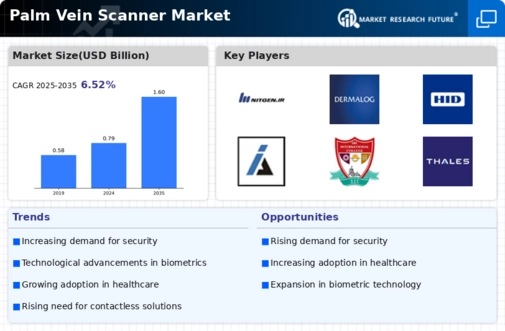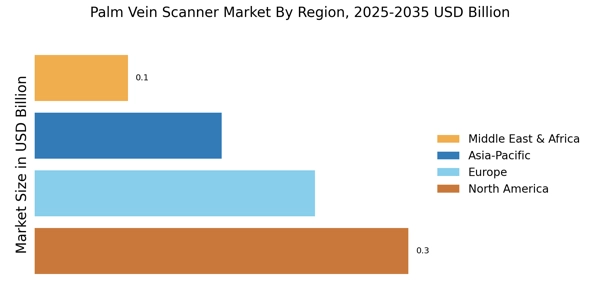Expansion of Retail and Financial Sectors
The Palm Vein Scanner Market is benefiting from the expansion of the retail and financial sectors, where secure payment and identification methods are increasingly prioritized. Retailers are adopting palm vein scanners to facilitate seamless transactions and enhance customer experience while ensuring security. Similarly, financial institutions are implementing this technology to prevent fraud and streamline customer onboarding processes. Recent market data suggests that the retail sector alone is expected to invest heavily in biometric solutions, with projections indicating a growth rate of over 15% annually. This trend underscores the importance of palm vein scanners in enhancing operational efficiency and customer trust, as businesses strive to create secure environments for transactions and interactions.
Increased Focus on Patient Safety and Privacy
In the Palm Vein Scanner Market, there is an increasing emphasis on patient safety and privacy, particularly within healthcare settings. Hospitals and clinics are adopting palm vein scanners to ensure secure patient identification and to protect sensitive health information. This technology minimizes the risk of medical errors associated with misidentification, thereby enhancing patient safety. Recent statistics indicate that healthcare organizations implementing biometric solutions have reported a reduction in identity-related errors by up to 30%. As regulatory frameworks continue to evolve, the demand for secure identification methods is likely to rise, further driving the adoption of palm vein scanners. This trend reflects a broader commitment to safeguarding patient data and ensuring compliance with privacy regulations, which is becoming a critical consideration in the healthcare sector.
Rising Demand for Biometric Security Solutions
The Palm Vein Scanner Market is experiencing a notable surge in demand for biometric security solutions. As organizations increasingly prioritize security, the adoption of advanced biometric systems, including palm vein scanners, is becoming more prevalent. This trend is driven by the need to mitigate identity theft and unauthorized access. According to recent data, the biometric market is projected to grow at a compound annual growth rate of approximately 20% over the next five years. This growth is indicative of a broader shift towards more secure authentication methods, positioning palm vein scanners as a critical component in the security infrastructure of various sectors, including banking, healthcare, and government. The unique characteristics of palm vein patterns, which are difficult to replicate, further enhance their appeal in the Palm Vein Scanner Market.
Growing Integration with Internet of Things (IoT)
The Palm Vein Scanner Market is witnessing a growing integration of palm vein scanning technology with Internet of Things (IoT) devices. This integration allows for enhanced data collection and real-time monitoring, which can significantly improve operational efficiency across various sectors. For instance, in smart buildings, palm vein scanners can be linked with access control systems to streamline entry processes while maintaining high security. The convergence of biometric technology with IoT is expected to create new opportunities for innovation, as organizations seek to leverage data analytics for improved decision-making. Market analysts suggest that the IoT-enabled biometric market could reach a valuation of several billion dollars within the next few years, indicating a robust growth trajectory for palm vein scanners as part of this technological evolution.
Rising Awareness of Biometric Technology Benefits
The Palm Vein Scanner Market is experiencing a rise in awareness regarding the benefits of biometric technology among consumers and businesses alike. As educational initiatives and marketing campaigns highlight the advantages of palm vein scanning, including its accuracy and user-friendliness, more organizations are inclined to adopt this technology. The unique attributes of palm vein patterns, which offer a high level of security, are becoming increasingly recognized. Surveys indicate that a significant percentage of consumers express a preference for biometric authentication methods over traditional passwords. This growing awareness is likely to drive demand for palm vein scanners across various industries, as organizations seek to enhance security measures and improve user experience.

















Leave a Comment